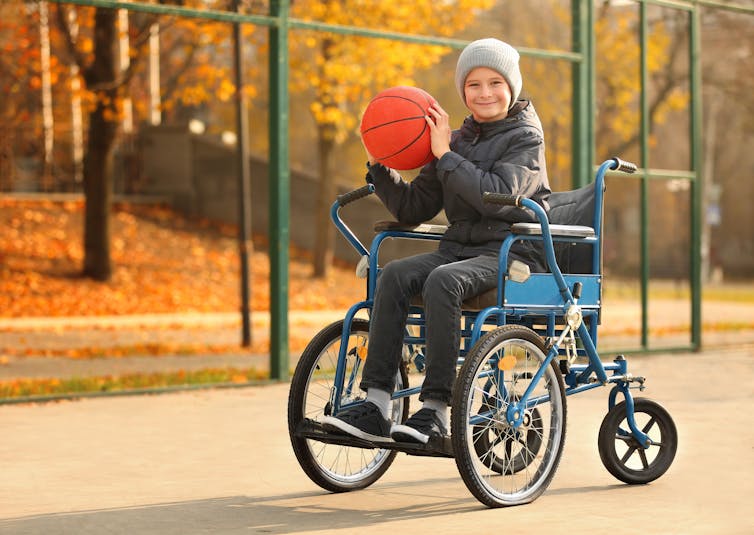Canada’s 2018 Report Card on Physical Activity for Children and Youth, published by the national non-profit organization ParticipACTION, gives Canadian children and youth an overall D+ grade for physical activity.
It calls for Canadian kids to get up and move.
For the first time, the report makes specific mention of the importance of physical activity to children with disabilities. Our team at the Kids Brain Health Network proudly contributed to, and enthusiastically endorses, its findings and recommendations.
This report card focuses on the connection between exercise and brain health, not for the sake of fitness alone, but for the health of their developing brains. It is a vital clarion call for change.
However, if all Canadian children are to enjoy their rights to play and participate, that call needs to be supported and amplified by voices at all levels.
Multiple, well-identified barriers stand in the way of children and youth with disabilities who want — and absolutely need — to be active. Research, commentary and coverage have yet to uproot those obstacles.
Lack of equipment, inaccessible facilities
Strategy and policy are important promoters of physical activity and sport, but when it comes to adapted programming for kids with disabilities, they are distinctly lacking.
Most extracurricular physical activity programming in Canada is offered through city and community organizations. There are many excellent accessible sites, but not enough to meet the need, and there is little or no coordination of efforts or offerings.
Physical Activity for Child Development: A partnership between Special Olympics of B.C. and the Kids Brain Health Network.
A lack of appropriate equipment, coupled with a lack of professionals trained to support physical activity among children and youth with different ability levels, discourages participation.
Often, existing adapted and inclusive activities are not known to parents of children with disabilities, as they depend on word of mouth. Additional barriers can include inaccessible facilities and high costs of entry.
One parent told us: “I was so tired of this experience of trying something, and having my son feel like a failure because he can’t meet the expectations.” This mother and her son had both had enough.
Their frustration is such a frequent experience it has triggered interest in improving crucial first experiences with sport for children of all abilities.
Early, positive exposure to sports and physical activity encourages children to try and not give up. But negative experience is a significant deterrent — especially to ongoing participation for children with disabilities.
A significant step towards inclusion came last week, with the tabling of the federal Act to ensure a barrier-free Canada. The Act proposes to identify, remove and prevent accessibility barriers in areas of federal jurisdiction.
This long-awaited legislation addresses federally-run programs and built environments, but it remains to be seen whether it will address or remove barriers to participation in sport and leisure activity.
Active kids grow stronger
Let’s focus for a moment on what the data is telling us about why physical activity is so important for children and youth with disabilities.
We know that obesity and mental health issues — including attention deficit, anxiety and depression — are becoming more common among all children. They are even more prominent among children and youth with disabilities, especially those that are brain-based or neurodevelopmental, such as autism, ADHD or fetal alcohol spectrum disorder.
Even a single game, workout or activity can improve the capacity to focus in children with disabilities. Physical activity can also contribute to better cognitive performance, memory, the ability to problem-solve and decision-making. Active children have better executive functioning, including planning, self-regulation and the ability to perform demanding tasks with greater accuracy.

Physically-disabled children can find it hard to access sports, due to lack of appropriate equipment and adequately-trained professionals.
Because of previous exclusion or limited access, children with brain-based disabilities are likely to experience the greatest benefits in these areas when they participate in physical activity.
It’s all about the cycle of conditioning: active kids who stay active grow stronger and more physically literate as they age. The cycle of deconditioning works the same way: for children who don’t participate, the less they do, the less they’re able to do.
Physical activity can help support mental health and wellness among children and youth, minimizing symptoms of depression, diminishing anxiety and increasing resilience to stress.
Beyond the benefits to body and mind, participation also promotes inclusion. Social communication, activities of daily living and quality of life all improve with exercise — not only for the children but their families as well.
Mapping Canada with an app
Kids Brain Health Network, a federally funded Network of Centres of Excellence, supports research in physical activity to improve training among coaches, support staff and program managers. The network also develops capacity to support parents of kids within existing programs.
A key partner in this effort is Special Olympics B.C. Together, we’re developing a program to promote best practices and expand the range of children involved in Special Olympics activities.

The rights of children to play and be healthy are established in international law.
Another project we support is the Jooay App — designed to help children with disabilities and their families locate accessible sport and leisure opportunities close to home that suit their needs and abilities and match their preferences.
In addition to centralizing and highlighting what’s available, Jooay is also starting to map areas in Canada that are most deprived of these opportunities.
The rights of children to play
Solutions on the ground are vitally important, but we must also engage with policymakers and at the community level to ensure that policies, procedures and practices that prevent children with disabilities from participating get addressed.
We’re doing that through policy briefs and direct encounters at the federal and provincial levels, highlighting the rights of children to play and be healthy — as established in international law. In addition, we are working to generate community consensus on the steps needed to increase participation for children with disabilities.
We’re also listening to Canadian youth with disabilities who support our policy outreach. They tell us they want to participate in the same activities as their friends, in the communities where they live. They need coaches, staff and peers who are friendly and welcoming.
The solutions aren’t necessarily complex. They require involving children and youth with disabilities, and thinking inclusively as an integral part of planning health promotion and public health campaigns.
So, let’s get moving.



 Trump’s U.S. Open Visit Delays Final, Fans Face Long Security Lines
Trump’s U.S. Open Visit Delays Final, Fans Face Long Security Lines  Trump Threatens Stadium Deal Over Washington Commanders Name
Trump Threatens Stadium Deal Over Washington Commanders Name  Trump Plans UFC Event at White House for America’s 250th Anniversary
Trump Plans UFC Event at White House for America’s 250th Anniversary  Asia’s IPO Market Set for Strong Growth as China and India Drive Investor Diversification
Asia’s IPO Market Set for Strong Growth as China and India Drive Investor Diversification  Morgan Stanley Boosts Nvidia and Broadcom Targets as AI Demand Surges
Morgan Stanley Boosts Nvidia and Broadcom Targets as AI Demand Surges  US Reviewing Visa Denial for Venezuelan Little League Team Barred from World Series
US Reviewing Visa Denial for Venezuelan Little League Team Barred from World Series  Why is soccer fandom so linked to violence?
Why is soccer fandom so linked to violence?  From Messi to Mika Häkkinen: how top athletes can slow down time
From Messi to Mika Häkkinen: how top athletes can slow down time  Bitcoin Defies Gravity Above $93K Despite Missing Retail FOMO – ETF Inflows Return & Whales Accumulate: Buy the Dip to $100K
Bitcoin Defies Gravity Above $93K Despite Missing Retail FOMO – ETF Inflows Return & Whales Accumulate: Buy the Dip to $100K  Why the Australian Open’s online tennis coverage looks like a Wii sports game
Why the Australian Open’s online tennis coverage looks like a Wii sports game  Trump Attends Super Bowl Amid Cheers, Boos, and Political Divide
Trump Attends Super Bowl Amid Cheers, Boos, and Political Divide 

































